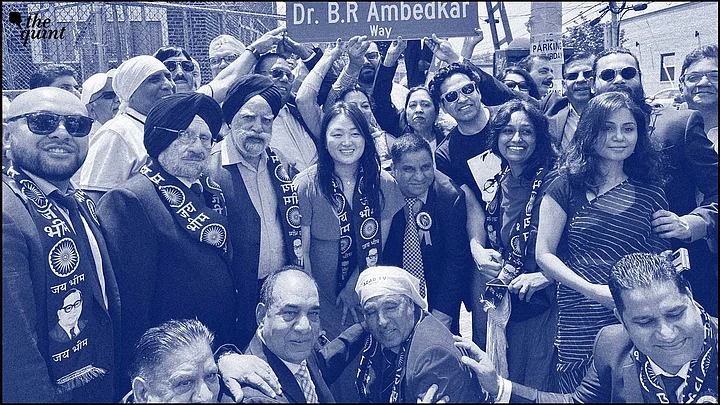Hundreds of Ambedkarites gathered in New York on Sunday, 25 June, to participate in a ceremony co-naming a street intersection after Dr BR Ambedkar.
A street plate bearing the words 'Dr. B.R Ambedkar Way' was put up at the intersection of Broadway and 61st Street in Woodside, Queens in the chants of 'Jai Bhim.'
The event was attended by New York City council member Julie Won, Congresswoman Grace Meng, New York State assembly member Steven Raga, and New York State Senator Michael Gianaris along with several activists and ordinary citizens.
The civil society organisations Shri Guru Ravidass Temple of New York and Begumpura Cultural Society of New York led the efforts in convincing the city council to take this decision.
Hardev Sahai, international coordinator of the Begumpura Cultural Society, told The Quint that when they reached out to the administration six months ago, the response they received was quite positive.
Won, who represents the 26th district, of which Woodside is a part, wrote on Twitter:
"Dr. Ambedkar was an activist, economist, Columbia grad, Minister of Law, and father of India’s constitution. His life and work against the discrimination of Dalits, women, and religious minorities are a profound example of overcoming adversity and fighting for justice."
Ambedkar's primary association with the city is through Columbia University, where he earned an MA and PhD.
Akash Singh Rathore, in his new biography Becoming Babasaheb: The Life and Times of Bhimrao Ramji Ambedkar, says that New York played an important role in shaping Ambedkar's understanding of caste in his formative years.
"Young Ambedkar's emerging academic understanding of caste was helping him give systematic expression to his many prior years of the lived experience of systemic caste prejudice. Alongside and as an impetus to this were also his widening experiences on issues of race, class and gender. To some extent, this new exposure came more experientially, from treading the streets of Upper Manhattan and Harlem."
New York's thoroughfares pay tribute to many renowned personalities, from musicians to politicians to social activists. The broad criteria for such an honour are that the person must be dead, should be worthy of recognition and should be largely free of controversy.
The process is called co-naming because the street retains its current name as well.
(At The Quint, we question everything. Play an active role in shaping our journalism by becoming a member today.)
